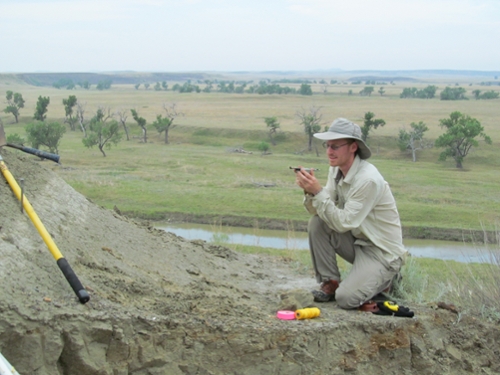Rowan-led research identifies chemical tool for finding proteins in fossil bones
Rowan-led research identifies chemical tool for finding proteins in fossil bones

Rowan University paleontologist Dr. Paul Ullmann is the lead author on new research into the preservation of ancient biomolecules, such as dinosaur proteins.
The molecules include preserved blood vessels and blood material, pigment cells and proteins that have been observed in recent years by a number of researchers working in the emerging field of molecular paleontology.
Published in the journal Scientific Reports Sept. 23, the research is reminiscent of that in the mega movie franchise Jurassic Park, in which scientists extract a bit of DNA from a mosquito lodged in a piece of solidified amber and, from it, recreate a world of dinosaurs.
Though Ullmann and his team do not seek to reanimate extinct dinosaurs, they used an array of molecular biology techniques to identify preservation of the protein collagen in a 67 million year old bone of the duck-billed dinosaur Edmontosaurus.
“When you perform molecular biology tests on certain fossils, you can recover original, ancient molecules,” said Ullmann, an assistant professor in Rowan’s Department of Geology. “We haven’t succeeded with DNA, like in Jurassic Park, but my colleagues and I have recovered ancient proteins.”
Ullmann said big questions remain, including how it’s even possible that genetic material can be viable for millions of years in fossilized dinosaur bones.
“That’s part of what we’re trying to figure out,” he said.
Researchers for the article, “Molecular tests support the viability of rare earth elements as proxies for fossil biomolecule preservation,” included Dr. Ken Lacovara, dean of Rowan’s School of Earth and Environment and Rowan Assistant Professor Dr. Kristyn Voegele.
“Scientists are just beginning to understand the processes that lead to the preservation of minute bits of ancient flesh trapped inside fossils,” Lacovara said. “This work sheds light on the conditions that make these amazing discoveries possible.”
Groundbreaking research
Ullmann said the project began eight years ago when he and Voegele were doctoral students under Lacovara at Drexel University. To investigate how groundwater chemistry influences the decay of molecules in bones, Ullmann began studying a vast dinosaur bonebed in South Dakota. Part of his work involved firing a laser at slices of the bones to determine their elemental chemistry, which hinted that the bones had been little altered over the millennia, and that led his team to predict they might contain ancient molecules.
Ullmann said he and other paleontologists have not only identified ancient proteins in fossilized bones but demonstrated that they derive from the animals themselves and not environmental contamination.
“For the first time, we’ve identified a chemical signature, or indicator, for molecular preservation in fossil bones,” Ullmann said. “In the end, the real benefit of our work is that scientists can use this tool to make more ancient molecule discoveries, which then have numerous and diverse applications, everything from learning about the physiology and biology of dinosaurs to pathways of molecular evolution.”
“Like bar codes on fossils”
While Ullmann’s research never sought to reanimate long-extinct species, he said comparisons to the Jurassic Park storyline are easy to make.
“Molecular recovery is an idea that is gaining real traction in paleontology, the most famous of which is the notion that we can use ancient DNA to resurrect animals like dinosaurs and the wooly mammoth,” he said.
Which isn’t very likely.
“The real promise of molecular paleontology,” Lacovara said, “is that it’s like having bar codes on fossils. As this technology develops, paleontologists will be able to test hypotheses about ancient creatures in the same way that biologists use molecular fingerprints to study living animals today.”
“These discoveries are advancing scientific knowledge of how molecules evolve over time and how extinct animals responded to past climate change,” Ullmann said. “The technological advancements required to recognize molecular fragments in fossils may one day see applications in everything from medicine to materials engineering.”
To learn more, take a deeper dive into the research in a fascinating Q&A with Ullmann.
Read the team’s paper in Scientific Reports.